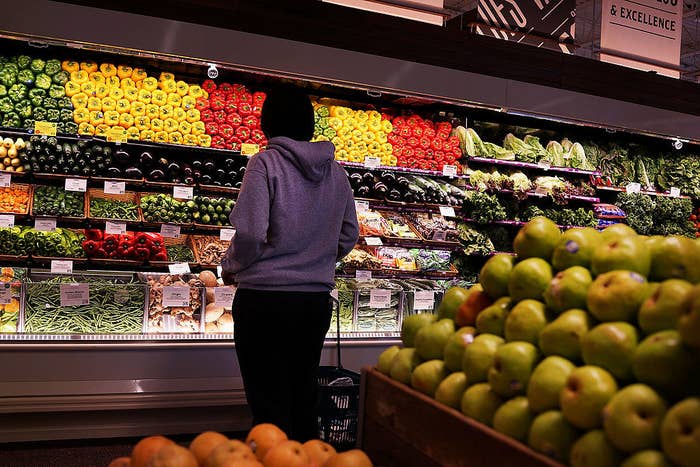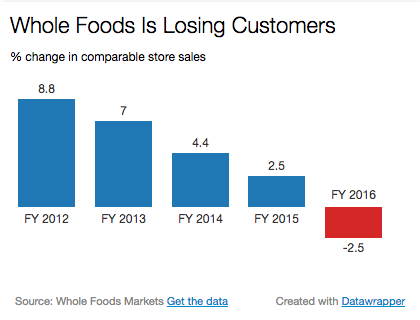
Being a "buyer" for Whole Foods — the people who traverse the country finding products to sell on its store shelves — can earn you a certain kind of celebrity status in the food industry.
Getting your product on the shelves at Whole Foods can be a ticket to riches, and when people hawking their all-natural snacks find out a Whole Foods buyer is in the room, the result can look like Kim Kardashian being swarmed by the grocery paparazzi. "You're just a human being, and you need to be able to breathe," recalls Tim Sperry, a 15-year veteran of Whole Foods who now is a natural food consultant.
But while buyers like Sperry curated Whole Foods' dazzling selection of natural, organic and gourmet foods, the company's technology infrastructure was been far less impressive — a flaw rooted in its history as a highly decentralized business. Whole Foods had 12 different IT systems running across its stores in 2015, when it finally began consolidating them into one, reported pymnts.com. It only unified its point-of-sale system in 2016.
The decentralized management was designed to help stores focus on offering locally grown and made products, a popular selling point for customers. But it reduced the company's ability to crunch the numbers on its overall supply chain, inventory, pricing and sales — all major opportunities for grocery companies trying to master the big data game.
The regional focus also limited its ability to launch a rewards program, a robust mobile app, and other online services that were taking off in other segments of retail.
"IT at Whole Foods has always been weak," Sperry said. "In the early days, we loved the decentralization.... But when you’re a $15 billion company, you really need to be operating on one platform."
Those struggles, Sperry says, contributed to the overall troubles at Whole Foods in recent years, with the chain losing customers and its stock price slumping. But now, Amazon's $13.7 billion takeover could quickly turn things around.
"This deal puts them lightyears ahead," said Errol Schweizer, a former Whole Foods executive and industry advisor. "Amazon picks up Whole Foods' experience in perishables, and Whole Foods gets Amazon's data, platform and pricing tools."
While details are not yet clear, merging with Amazon potentially opens up a vast online customer base for Whole Foods, helping it leapfrog grocery competitors that have also been looking at online sales. Amazon has 80 million US subscribers to its Prime delivery program, and an estimated 42% of all US consumers bought something from Amazon last year according to the NPD Group,
In addition to e-commerce, Amazon is also testing new ways to make brick-and-mortar shopping faster and easier. It runs a checkout-free, grab-and-go store in Seattle, using technology that could eventually be rolled out at Whole Foods stores, which often have long lines.

Whole Foods was trying other ways to keep up with the times — it was one of the first retailers to launch Apple Pay and it partnered with grocery delivery service Instacart in 2014 — but its fragmented tech infrastructure meant it remained fundamentally splintered as competitors from Wal-Mart and Costco to Kroger were rapidly expanding their own natural food offerings.
It also showed a complacency about the threat posed by its biggest competitors. In 2015, as Amazon and Walmart were moving aggressively toward online grocery delivery, its CEO told Bloomberg that he was not worried about the competition, and that online grocery delivery would be "Amazon's Waterloo."
By 2016, sales at existing Whole Foods stores turned negative. The company declined to comment for this story.

Food manufacturers that now sell to Whole Foods see the deal as an opportunity to reach new consumers, and hopefully shake off the grocer's "whole paycheck" reputation. "Amazon has a brand of offering the best prices to consumers,” said Nona Lim, who makes a line of soups and bone broths that retail for about $5. “Whole Foods is priced competitively, but consumers may not know that because of the impression they have about their pricing. Maybe this can change their perception.”
“Fresh foods are the final frontier for Amazon. And figuring out how to get it to your front door is the ultimate in convenience for consumers. In order for Amazon to get the volume growth they are looking for, fresh foods has to be part of the equation," David Portalatin, NPD Group's vice president of industry analysis, Food, in an emailed statement. "This deal gives them credibility with consumers and a major foothold in that space.”
